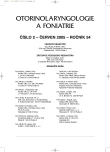Reliability of SSEP Method in the Examination of Hearing in Young Children
Authors:
P. Myška; M. Jurovčík; Z. Kabelka; E. Vymlátilová; J. Štěpánek 1
Authors‘ workplace:
Foniatrické oddělení a Centrum kochleárních implantací u dětí
Klinika ušní, nosní a krční 2. LF UK a FN Motol, Praha
přednosta doc. MUDr. Z. Kabelka
Zvukové studie HAMU, Praha
; vedoucí studia prof. Ing. V. Syrový, CSc.
1
Published in:
Otorinolaryngol Foniatr, 54, 2005, No. 2, pp. 82-86.
Category:
Original Article
Overview
Summary:
The study presents the comparisons of results of two examinations of hearing carried out in young children by means of the Steady State Evoked Potentials (SSEP) method with the interval of several months. The SSEP method has been applied at our clinic since July 1999. Its main advantage is the frequency specificity. Patients are examined at the frequencies of 0.5, 1, 2 and 4 kHz. The study comprised 64 children, of whom 45 were later implanted. The results of the study indicate a high correlation of threshold values in the two examinatinos carried out by means of SSEP method and thus confirm its reliability.
Key words:
SSEP – Steady State Evoked Potentials, reliability.
Labels
Audiology Paediatric ENT ENT (Otorhinolaryngology)Article was published in
Otorhinolaryngology and Phoniatrics

2005 Issue 2
Most read in this issue
- Surgical Treatment of Lower Concha Hypertrophy by Means of Microdebrider
- Reflex Response of the Stapes Muscle Induced by Acoustic Stimulation: Systematic Arrangement of Conditions for the Induction
- Short-term and Long-term Functional Results of Stapedoplasty
- Experience in Vestibular Habituation Training in the Therapy of Balance Disorders
